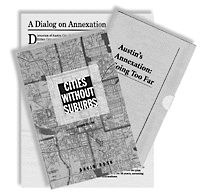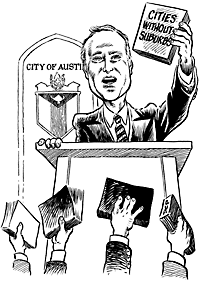https://www.austinchronicle.com/news/1997-11-21/518948/
Spreading the Gospel
The Mayor Shares His Favorite Book
By Kayte VanScoy, November 21, 1997, News
|
|
Watson says he came upon Cities while undertaking a systematic absorption of the current thinking on city planning when he was deciding whether to run for mayor. And although Watson says that he doesn't agree with everything put forward in Cities, he admits that his new policies are in line with the book. "Part of the reason I've talked about [Cities] the most is because it fits so neatly into what we're doing with annexation," he says.
But while city strategists like Watson have touted the book like holy scripture, not surprisingly, this city bestseller has been panned by annexation critics. They call into question not only Rusk's conclusion, but his qualifications and his statistical data as well.
Rusk didn't start out as a writer. He was the mayor of Albuquerque from 1977 to 1981, and has been a Washington, D.C.-based consultant for cities and corporations since 1991. When asked if he is comfortable with the book being used as a bible to revamp cities like Austin, Rusk simply replies: "Well, I wrote it for that purpose."
 Compiled primarily from 1990 census data and other governmental data from the early Nineties, his book puts forward a statistically-based argument for a dual strategy of pumping up central cities and encouraging regional planning. The point, Rusk says, is to create long-term economic sustainability by integrating neighborhoods across race and class lines. Published in 1993, and updated in 1995, Cities has made Rusk a one-man band on the city revitalization circuit. He estimates that he has been paid to consult in over 90 cities in the past five years, from the heartlands of the United States to the far flung towns of South Africa. And although he has only passed through Austin and has never spoken to Watson, Rusk is already the consultant -- in absentia -- for Austin's future growth.
Compiled primarily from 1990 census data and other governmental data from the early Nineties, his book puts forward a statistically-based argument for a dual strategy of pumping up central cities and encouraging regional planning. The point, Rusk says, is to create long-term economic sustainability by integrating neighborhoods across race and class lines. Published in 1993, and updated in 1995, Cities has made Rusk a one-man band on the city revitalization circuit. He estimates that he has been paid to consult in over 90 cities in the past five years, from the heartlands of the United States to the far flung towns of South Africa. And although he has only passed through Austin and has never spoken to Watson, Rusk is already the consultant -- in absentia -- for Austin's future growth.
And that is precisely the influence which suburbanites like Cliff Avery hope to forestall. Avery, a Pflugerville city councilmember from 1991 to 1994, has started his own one-man campaign putting out anti-annexation pamphlets on behalf of the MUDs as coordinator for the Central Texas Association of Utility Districts. Avery says he has known about Cities for several years. "They trot it out every time. [Former Mayor] Bruce Todd used it during the '95 legislature an awful lot," he says, launching into well-hashed annexation war stories of the '95 lege.
In Avery's pamphlets, "Austin's Annexation: Going Too Far" and "A Dialog on Annexation," Avery takes Cities and Watson to task. "Cities Without Suburbs... is not the Fifth Gospel," Avery writes, citing a wealth of other academic theories which refute Rusk's conclusions.
And Avery is not alone in his criticism. Academic debate over Cities -- raging this very minute on webpages all over cyberspace -- tends to pit Rusk's conclusions against those of Joel Garreau, who writes in Edge City that the concept of downtown is a "19th-century holdover" and stresses that growth in jobs and homebuilding nowadays is focused on suburbs. Watson responds that, in reading Edge City himself, he found it to be an argument against the rise of the suburbs more than an argument in favor of suburban superiority. Just goes to show you that every theory has its interpretation.
And in Austin these days, no book has more eager interpreters than Cities. Although the book is cursed again and again at the council's regular public hearings on annexation, it is clear that most critics have not turned page one and are only familiar with it through Watson's continued references. One of the staunchest critics of Austin's annexation policy, state Rep. Mike Krusee (R-Round Rock), admits he hasn't read the book, but was more than happy to slam it. "My understanding is that the book was written in the Seventies and based on research that was done in the Sixties," he says. Krusee's misconception is common among the huddled suburban masses, and stems directly from Avery's pamphlets which assert that Cities is based on a 1981 book which is in turn based on 1966 research. In fact, however, neither source is cited in Cities and, except for 1950s data used for the purposes of comparison, all data cited in Cities is less than 10 years old. Rusk says he uses more current data when consulting for a fee in local areas. "I don't know if there will be a third edition [to Cities], but when the year 2000 census comes out, I'll be on it like grizzly bear on raw meat," Rusk jokes.
In an interview with Tripod, an online magazine, Rusk explained that he considered his city planning reform work akin to the environmental or civil rights movements. Arguing against a purely capitalistic interpretation of "little box" communities, Rusk's mission extends beyond mere economics. All over the country, the arguments in favor of self-governing mini-communities like MUDs mirror those presently being promoted in Austin: that local control increases competition for lower property taxes and cheaper services. "If we follow that philosophy through, there'd be a competitive coming together over time. But the reality is [those communities] grow apart because people are not choosing based on taxes and services, they're choosing based on income and race," Rusk asserts. "Little box communities end up frustrating what we have held forth as the ideal for this nation: one nation indivisible, with liberty and justice for all."
No doubt our mayor would agree. One thing is for certain: Regardless of the theoretical bent behind Watson's annexation push, it is moving forward now with little hope of the alternative solutions for which most annexees are hoping. And Rusk, hearing of his newfound Austin celebrity, is busy pondering his first visit to the city he has so influenced.
This Week In Council: Final reading on the annexation of six of the annexation tracts.
Copyright © 2024 Austin Chronicle Corporation. All rights reserved.

